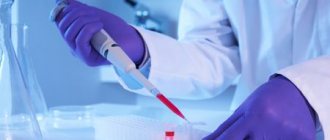What functions does this hormone perform?
17 OH progesterone is very important for the female body, performing the following tasks:
- affects the rate of blood flow to the heart muscle and muscle fibers;
- assists in burning fat deposits in stressful situations;
- stimulates puberty;
- responsible for the cyclicity of menstruation;
- is responsible for the process of conception and gestation.
The main function of 17 OH progesterone is to stimulate the reproductive system.
Norm and analysis of 17 oh progesterone in women
17 oh progesterone has a direct effect on reproductive function. By its biochemical nature, it is a metabolite in the chain of biochemical synthesis of sex hormones (testosterone and estradiol).
The norm of 17 OH progesterone in women is important for conception and the normal course of pregnancy. The amount of the substance must be controlled in newborns.
Preparation for delivery
The specifics of preparation before taking blood for 17 OH progesterone are determined by the attending physician. If no specific instructions were received from him, then no special preparation is needed.
On what day should I take 17 OH progesterone?
According to recommendations, you need to donate blood for this test from days 2 to 5 of the menstrual cycle.
It is better to go to the laboratory in the morning from 8 to 11 o'clock on an empty stomach.
On the eve of the examination, you should definitely give up alcohol, fatty foods, and smoking.
When and how to get tested?
The concentration of the hormone 17-OH can periodically change under the influence of external and internal factors, so you need to prepare for donating blood for analysis. Women need to donate blood in the first half of the menstrual cycle, but not earlier than the 3rd day of the cycle; The optimal time to donate blood is 3-10 days of the menstrual cycle. The same rule applies to mature girls. Men and immature children can donate blood for testing at any time, since they do not have menstruation, which directly affects the concentration of the hormone in the blood.
You must also donate blood in accordance with the following rules:
- If you are taking any medications or undergoing diagnostic tests, you should provide this information to your doctor during your consultation. The fact is that some medications and medical procedures affect the activity of the hormonal system, which can distort test results. If necessary, the doctor can either temporarily stop taking the medications or postpone the blood draw for a 17-progesterone test (usually the doctor makes this or that choice after consulting with the doctor who prescribed the medications).
- The day before donating blood, you should exclude spicy and sour foods, as well as alcoholic beverages and tobacco from your diet. Spicy foods take a long time to be processed by the body, which can distort the results of the examination. Tobacco and alcoholic beverages can also affect the test results, so they must be excluded from the diet without fail.
- 12 hours before donating blood, you need to limit physical activity. The fact is that during physical exercise the body experiences serious stress, which leads to changes in the functioning of internal organs. The functioning of the hormonal system also changes during exercise, and it will take 4-5 hours to normalize hormonal metabolism. In some diseases, normalization of the hormonal system takes longer, so it is recommended to increase the preventive period to 12 hours.
- 8 hours before donating blood you need to stop eating. If you donate blood in the morning, it must be done on an empty stomach. Such strict food restrictions are imposed due to the fact that during digestion the body actively synthesizes the substances it needs, so the body sometimes does not have time to synthesize both digestive enzymes and 17-progesterone, so deciphering the analysis may show incorrect results. It should be understood that such delays are minor and have virtually no effect on health.
- In the morning before the blood test, it is not recommended to drink any drinks - however, you are allowed to drink non-carbonated mineral water without additives. At the same time, you should not drink drinks even with natural additives (compotes, jelly, etc.), since even natural drinks contain substances that have energy value (that is, such drinks are actually food), which can distort the results of the examination.
Norms of hormone levels in the blood
There is no need to estimate the amount of 17 OH progesterone only based on the woman’s analysis. In order for the result to be as reliable as possible, the patient’s age must be taken into account.
Depending on the physiological characteristics and age, the value of the hormone 17 OH progesterone can vary within the following limits:
| Name of drugs | List of indications |
| Premarin | To restore hormonal levels during menopause |
| Estradiol | To restore hormonal levels in the blood |
| Presomen | To normalize the functioning of the reproductive organs |
| Tephastrol | To restore the vaginal mucosa and normal development of the uterus |
In addition, the level of this hormone in the fairer sex may vary depending on the phase of the menstrual cycle. Namely, in the luteal phase, a value of 0.32-2.9 a.u., 0.85-6.0 nmol/l is considered normal; during menstruation – 0.09-0.8 a.u., 0.19-2.3 nmol/l; during pregnancy – 0.68-4.02 USD, 0.9-11.8 nmol/l.
Increased level of 17 OH progesterone
The growth of the hormone can be a signal of physiological abnormalities in the body.
An increase in 17 OH progesterone is often observed in the following diseases:
- neoplasm in the adrenal cortex;
- polycystic disease;
- congenital adrenal hyperplasia.
The reasons for the increase in the hormone level can be emotional overstrain, in particular, stress, fear, anger.
Low hormone levels in the blood
It would seem that the less the better. But, this rule cannot be applied to reducing the amount of 17 OH progesterone. When a substance is less than normal, it is just as bad as its excess.
A woman should consult a doctor in the following cases:
- if menstruation is irregular;
- a couple cannot conceive a child for a long time;
- in case of miscarriage;
- with uterine bleeding;
- with amenorrhea;
- in case of increased sensitivity and soreness of the breast;
- with intense PMS;
- if ovulation does not occur during a normal cycle.
There is only one reason for the decrease in hormone levels - insufficient functionality of the adrenal glands, which leads to Addison's disease.
Increase in 17 hydroxyprogesterone during pregnancy planning and during gestation
This hormone is a steroid hormone; the ovaries and adrenal glands are responsible for its production. In women at position 17 OH, progesterone begins to be produced in the placenta.
An increase in oxyprogesterone levels in pregnant women indicates an increased synthesis of male hormones in the adrenal glands.
If the production of 17 OH progesterone during pregnancy is overestimated, the production of androstenedione increases. This, in turn, increases testosterone production, which is fraught with the following consequences:
- spontaneous termination of pregnancy in the 1st trimester;
- threat of premature birth in the 2nd trimester.
If a pregnancy often ends in spontaneous miscarriage, the patient is diagnosed with “recurrent miscarriage.” In this case, the woman needs to check her hormonal status, especially donate blood for 17 OH progesterone.
If this component exceeds the normal value, treatment is prescribed. Only after completion of therapy there is a chance to become pregnant and carry a child to term.
Normal during pregnancy
When planning a pregnancy, it is mandatory to take a blood test for 17 OH . It is included in the list of studies to determine hormonal status. At high values, problems with the menstrual cycle are noted. If the level of the substance is high and pregnancy has occurred, there is a high risk of miscarriage, and in the later stages - premature birth.
As a rule, pregnant women with elevated levels of hydroxyprogesterone also have high concentrations of other hormones:
- DHEA-S (androgens produced by the adrenal glands of women);
- cortisol;
- testosterone and others.
This condition requires careful examination and treatment.
If the hormone levels are low during pregnancy, it is necessary to check the fullness of its development. Deviation from the norm may indicate a frozen fetus or the presence of pathologies.
During pregnancy, the hormone is produced by the placenta, so you need to monitor the level of 17 OH over time. Its amount increases gradually, which indicates normal fetal formation:
| Trimester of pregnancy | Values in ng/ml |
| First | 1,3-3 |
| Second | 2-5 |
| Third | 5-8,3 |
In premature newborns, hydroxyprogesterone is elevated. This deviation from the norm of 17 OH is observed in the first 1-2 weeks of the baby’s life, then the hormonal levels stabilize on their own.
17 OH progesterone is necessary for full reproductive function . To determine hormonal status when planning pregnancy, it is included in the list of mandatory laboratory tests. Deviations from the norm in non-pregnant women indicate possible pathologies that need to be promptly identified and treated.
source
How to reduce the concentration of 17 OH
To reduce the amount of 17 OH progesterone, women are prescribed hormonal treatment. Often, drugs such as Dexamethasone and Methylprednisolone are prescribed for this.
Taking such medications can cause weight gain because they retain water in the body. Since hormone therapy is used in a small dosage, no other side effects were observed.
The specifics of the use of medicines are clarified by the doctor, taking into account the phase of the menstrual cycle, the manifestation of the disease and the individual characteristics of the body. The daily dose of the drug is divided into several doses with the same interval.
If a woman suffers from infertility, the duration of therapy until pregnancy can last from 3 months to six months.
Critical days and progesterone
Menstruation is a complex process that involves many parts of the body. From the reproductive system itself, to electrons in the brain and the concentration of hormones throughout the body. The critical days themselves last from three to seven days. And the entire cycle takes from 21 to 35 days (where, in fact, the name came from - menstruation).
The menstrual cycle is divided into several periods:
- Follicular phase. The period during which a new follicle is formed. A follicle is essentially an egg surrounded by a special protective layer. In it she “ripens” and prepares. This phase begins on the first day of the cycle (the first day of menstruation), lasts a week and ends just before ovulation.
- Ovulation. This is the time when the egg is fully formed and begins to move from the follicle to the uterus. This is the ideal period for fertilization. And if you set yourself such a goal, then you need to carefully monitor its beginning.
- Luteal phase. It is also called the corpus luteum phase. And all because, after its onset, in the place of the follicle (which the egg left earlier) in the ovaries, a temporary gland is formed - the corpus luteum. It is busy producing hormones that help the body prepare to receive a fertilized egg. Isn't there one this month? This means that the corpus luteum regresses, the epithelium around the unfertilized egg dies and menstruation begins. And so on until next time. That's it, the cycle is closed.
17-OH progesterone is a hormone produced by the temporary gland. It is its presence and quantity that determines how ready the female body will be for fertilization and how well the gestation period will pass.
Depending on the period of a person’s life, the blood contains different amounts of certain hormones, including progesterone.
The maximum value is recorded during fetal development and in the very first days of the newborn (regardless of gender).
Analysis results
After donating a blood sample, the results of the study can be in 3 variations:
- norm;
- increased;
- downgraded
Taking into account the results obtained, the doctor selects the appropriate treatment.
Normal
If the 17 OH levels of progesterone are within the normal range, this means that the hormone imbalance is not related to the functioning of the ovaries or the adrenal cortex. In this case, the causes of hormonal imbalance should be looked for further.
Increased
An increase in the value of this hormone may indicate malignant neoplasms in the adrenal glands or ovaries.
Often, with a slight increase in 17 OH progesterone, girls complain about the absence of menstruation days, as well as problems with conceiving a child.
Decreased
Low levels of the hormone often indicate adrenal dysfunction (the disease can be either congenital or acquired).
In addition, reduced levels of 17 OH progesterone can also be recorded in men with signs of false hermaphroditism.
Normal for women
The norms of 17 OH progesterone in women depend on the phase of the uterine cycle:
| Phase | Hormone concentration in ng/ml |
| Follicular | 0,1-0,8 |
| Ovulatory | 0,3-1,4 |
| Luteal | 0,6-2,3 |
An increased level of the hormone indicates the presence of the following pathologies:
- adrenal dysfunction;
- benign and malignant tumors of the gonads;
- adrenal hyperplasia (congenital);
- the body's reaction to taking hormonal drugs with progesterone.
A decrease in hormone concentration is associated with congenital or acquired adrenal insufficiency and the presence of Addison's disease.
Reviews
Valeria, 31 years old
During the first pregnancy, it was not possible to carry the fetus to term; after 1.5 months, the embryo was rejected. This was accompanied by bleeding. The problem was not solved for many years. One day, going to another gynecologist, she focused on the fact that my hair was not growing in exactly the places where it should be, and advised me to check 17 OH progesterone. I was shocked... The results obtained exceeded the permissible norm by 6 times. Then the Doctor recommended taking a quarter of a Metipred tablet, which I used from the 3rd week of pregnancy until the 36th. The pregnancy was going well. Now a happy mom!
Tatyana, 24 years old
Despite the high levels of 17 OH progesterone, the gynecologist recommended reducing not it, but prolactin. For this purpose, I took Bromocriptine in a minimal dosage. I switched to work a little and stopped thinking all the time about not being able to get pregnant. 3.5 months later, on our wedding anniversary, I pleased my husband with two stripes on the test.
Decoding and deviations from the norm
Let's now find out what the concentration of 17-OH progesterone is in a healthy body:
Age and gender
| Concentration of 17-OH progesterone (units: ng/ml) | |
| Newborn boys and girls | 0,6 – 2,2 |
| Immature boys and girls | 0,9 – 2,6 |
| Puberty boys and men | 1,2 – 6,4 |
| Puberty girls and women (luteal phase) | 3 – 13 |
| Puberty girls and women (follicular phase) | 1 – 3 |
| 1st trimester of pregnancy | 3,6 – 18 |
| 2nd trimester of pregnancy | 4 – 20 |
| 3rd trimester of pregnancy | 3,7 – 33 |
To make a differentiated diagnosis, the doctor must conduct additional examinations. Please note that deviations from the norm occur at different times for different reasons. Therefore, after receiving the results, you should immediately consult a doctor for further diagnosis, and in case of a serious diagnosis, you should adhere to the treatment plan drawn up by the attending physician, since self-medication of hormonal disorders can pose a health hazard.
What does it mean to increase and decrease progesterone levels?
An abrupt and sharp increase in level occurs during the period of ovulation and during the second half of the luteal phase. This is a completely normal and natural process, which is a direct confirmation of the body’s readiness for procreation. This is when the body needs a hormone like progesterone most. This is like a kind of signal for the whole body to prepare, because the likelihood of fertilization is high. Another sharp hormonal surge occurs in the third trimester, during pregnancy. This is already the result of preparation for the birth of a child.
When the levels of such an important hormone seriously exceed the upper limits, this is a reason to think about your health.
So, if 17-OH progesterone is elevated in the follicular phase, then the reasons should be determined as soon as possible. This can cause serious problems with conception, since the process of preparing the uterus and egg will be disrupted - ovulation is suppressed, the egg does not move along the intended route.
One of the first alarm bells indicating this problem is delays in menstruation, which alternate with heavy, painful discharge. Some girls even stop menstruating for several months, despite the fact that they are at the peak age for fertilization and are still very far from menopause.
Incorrect functioning of the ovaries (including tumors), improper absorption of the hormone, and diseases of the urinary and reproductive systems can increase the level of the hormone.
If progesterone is increased in the luteal phase, then there may not be many reasons. According to gynecologists, there are only three of them:
- The body is in peak condition and is ready for fertilization “to the maximum.”
- Pregnancy has already begun.
- Any of the previously taken medications gave this side effect.
Lack of the hormone affects the body extremely negatively. A decreased level of progesterone in the luteal phase is an extremely dangerous trend. It can indicate a variety of hereditary and acquired diseases, and can lead to complications during pregnancy and miscarriage.
As the practice of gynecologists shows, this problem is most often associated with dysfunction of the adrenal cortex. A woman’s body is simply not able to produce the required level of the hormone. This problem is discovered during puberty. It’s good that at this moment the girl still has enough time to prevent unpleasant consequences. If the disorder is discovered later, the therapy may be delayed or may not bring any results at all.
Lack of progesterone leads to untimely or incorrect production of luteinizing hormone in the next cycle. The entire rhythm of the reproductive system is disrupted and, as a result, infertility. This problem is also often associated with Addison's syndrome, in which the adrenal glands cannot cope with the production of all hormones. It is possible to increase the level artificially, but this can have a negative impact on all other organs.
Normal values
What indicators are considered normal? How much of a hormone called 17 hydroxyprogesterone does a woman have in her blood? The norm for non-pregnant women depends on age. Small increases or decreases are not dangerous. But ideally you need to focus on the following values:
- Newly born girls - 4.08-29.4 nmol/l.
- 2-3 months - 0.3-9.4 nmol/l.
- From 12 months to 14 years - 0.42-6.9.
- Adolescents from 15 years old - 0.5-11.5 nmol/l.
- Women during the follicular phase - from 0.5 to 8.24 nmol/l.
- Women during the luteal phase - 1-11.5.
- Postmenopause - not less than 0.7 and not more than 5.9 nmol/l.
- Pregnancy - from 3.6 to 33.3 nmol/l.
Accordingly, such indicators indicate the absence of certain diseases. As already mentioned, 17 hydroxyprogesterone may deviate slightly from the indicated norms when a woman is in full health.
Factors
After ovulation, the remaining granulosa cells that are not released with the oocyte continue to enlarge, become vacuolated in appearance, and begin to accumulate a yellow pigment called lutein. Luteinized granulosa cells combine with newly formed theca cells and surrounding stroma in the ovary to become the so-called corpus luteum. It is a transitional endocrine organ that predominantly secretes progesterone; its main function is to prepare the endometrium for implantation of a fertilized oocyte.
The basal lamina dissolves and capillaries penetrate the granulosa cell layer in response to the secretion of angiogenic factors. Peak vascularization (the stage at which new blood capillaries form within the tissue) occurs 8–9 days after ovulation. This time also corresponds to peak serum progesterone and estradiol levels. The lifespan of the corpus luteum depends on constant LH support. If pregnancy does not occur, the corpus luteum undergoes luteolysis (resorption) under the influence of estradiol and prostaglandins, forming scar tissue in place of the corpus luteum.
In the early stages, the corpus luteum produces progesterone in concentrations necessary for a normal pregnancy. The following concentration of minor progestin in the luteal phase is considered normal: 6.99–56 nmol/l.
Menstruation
Menstruation is the cyclical, orderly release of the uterine lining in response to the interaction of hormones produced by the hypothalamus, pituitary gland and ovaries. The female cycle is divided into two phases: follicular (proliferative, FF) and luteal (secretory). Its duration is the number of days between the first bleeding and the start of the next.
The average duration of the menstrual cycle is 28–30 days. Patients with MC for less than 21 days are diagnosed with polymenorrhea, and for more than 35 days - oligomenorrhea.
During the menstrual cycle, a woman loses up to 30 ml of blood; if the volume exceeds 80 ml, immediate diagnosis and treatment is required.
FF begins with the first appearance of the critical days and continues until the process of egg release. It is characterized by the formation of follicles, which leads to estrogen-stimulated proliferation of the endometrium (uterine lining).
The LH (lutinizing hormone) wave is initiated by a sharp increase in estradiol produced by the prevulsory follicle and leads to ovulation. At this time, granulosa cells are stimulated and progesterone is synthesized, which is responsible for the surge in FSH (follicle-stimulating hormone) of the middle cycle. In addition, the release of LH stimulates the resumption of meiosis and the completion of division reduction in the oocyte with the release of the first corpus luteum (corpus luteum).
The luteal phase is relatively constant in all women, its duration is 14 days. The variability in cycle length is due to the different onset of the follicular phase, which can vary from 10 to 16 days.
If conception does not occur, the hormone concentration begins to fall and menstrual bleeding occurs.
Influence
17-OHP progestin differs from regular progesterone by an additional hydroxyl radical at the 17th carbon atom in the steroid skeleton of the molecule.
This intermediate product is responsible for attaching the embryo to the mucous membrane of the uterus and regulates the growth of the reproductive organ during gestation. Also, 17-hydroxyprogesterone inhibits the muscle activity of the uterus to prevent spontaneous abortion.
It helps raise blood pressure and prepares the fallopian tubes for the passage of the egg.
This hormone mainly affects the reproductive function of the body, it increases BTT, acts on the central nervous system, causing some behavioral characteristics during the premenstrual period.









